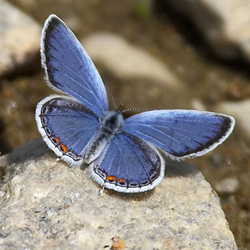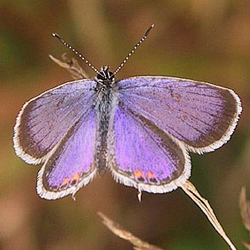Butterfly Atlas
Find a Butterfly
Eastern Tailed Blue
Everes comyntas
Named
Godart, 1824

Identification
Wingspan: 3/4 - 1". Of the small blues occurring in Massachusetts this one is distinguished by tiny, threadlike tails sometimes absent due to wear, and small orange patches on the hindwing below.
Distribution
Central Plain States east through most of Eastern North America; southern Canada south to central Florida. Also disjunct populations in California, Arizona, and New Mexico. Throughout New England excepting northern Maine.
Status in Massachusetts
Of this little blue, Scudder (1889) stated "it is found throughout New England even in the White Mountain district and is everywhere a common insect, especially in the southern half". Currently, this species remains a common butterfly in Massachusetts and is found throughout the state from the western border to the eastern most portion of Cape Cod. Maxima: 400, 27 August 1988, Salisbury (Essex Co.).

Flight Period in Massachusetts
Three flights: Mid May through early June, mid July through late July, and mid to late August through mid to late September. Extreme dates: 27 April 1995, Sudbury (Middlesex Co.), T. Dodd and 18 October 1992, Mansfield (Bristol Co.), B. Cassie.
Larval Food Plants
Legumes including vetches (Vicia), ticks-trefoils (Desmodium), and clovers (Trifolium).
Adult Food sources
Noted nectaring at 30 species of wildflowers, from Wood Sorrel and Low-bush Blueberry in May to asters and clovers in October.

Habitat
A variety of open areas including fields, agricultural edges, waste lots, and power line cuts. Our other small blue Spring Azore, is more likely seen along woodland edge.
Life Cycle
EGG: Pale green and white; turban shaped with ridges forming regular polygons. OVIPOSITION: Eggs laid singly on flower stalks or buds. LARVA: Dark green to pale yellow with dark dorsal stripe and brown head. CHRYSALIS: Pale green and tan, spotted with black or whitish markings. OVERWINTERING STAGE: Larva
Successive flights of adults may be seen throughout the summer months. As is the case with other multi brooded butterflies, the three annual generations of E. comyntas may look substantially different. The first flight adults are often smaller and display more distinct markings; the females of this first flight are typically deep blue above while those of subsequent flights are often brownish above. Larvae feed variously on flowers, fruit, and leaves. Third generation caterpillars overwinter, often in pods of host plant.
Account Author
Richard K. Walton



